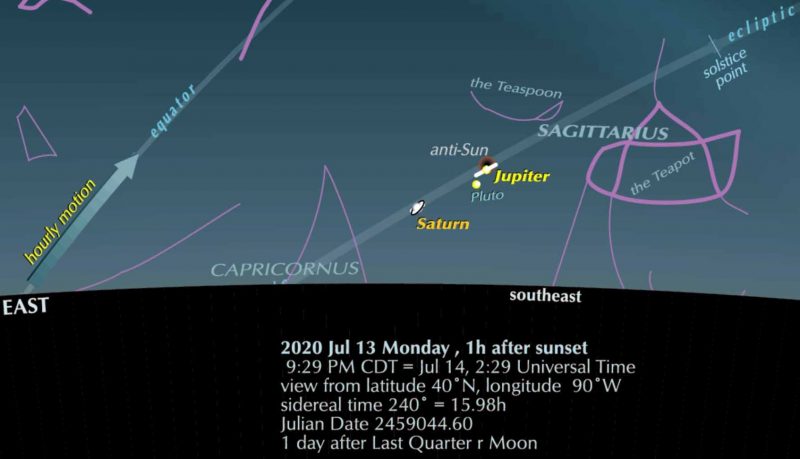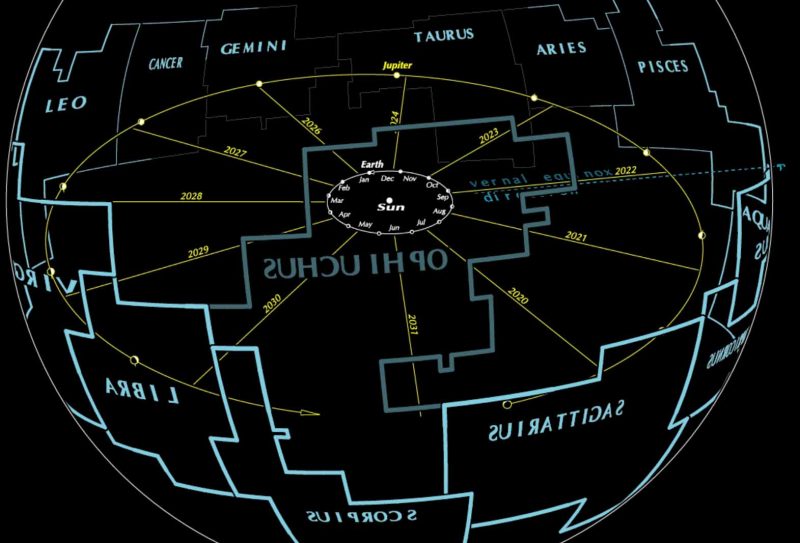

View larger. | The moment in 2020 when Jupiter is in the opposite direction from the sun is July 14 at 08:00 UTC. This is 2 a.m. in, for instance, the Central time zone of North America. So our sky scene – above – is for the nearest evening, Monday July 13, just a few hours before Jupiter’s exact opposition. Chart via Guy Ottewell’s blog.
Originally published July 11, 2020, at Guy Ottewell’s blog. Reprinted with permission. By the way, Guy’s new book is out! It called Venus, A Longer View.
In 2020, Jupiter comes to opposition on July 14 at 08:00 UTC. At that moment, Jupiter is most nearly opposite the sun in our sky for this year.
Because Jupiter is opposite the sun, it rises about sunset. This year, it is accompanied in the remote background by invisible Pluto. It is followed, a few degrees later, by Saturn, whose turn at opposition will come on July 20. At the time depicted in the chart above, Jupiter has reached 10 degrees above the horizon. As the night goes on, the planets will climb to the meridian of the sky around midnight.
In the chart above, the short arrows through the symbols for the planets represent their movement over five days. They are retrograding – moving slowly back westward – during the time, centered on opposition, when Earth is overtaking them.
Because Jupiter is only about a quarter of a degree south of the ecliptic (through which it descended on February 26), it is almost exactly at the point we have marked as the “anti-sun.”
And it is not far past the solstice point, where the sun is at the December solstice – the most southerly point of the ecliptic. This is one of the most southerly oppositions in Jupiter’s 12-year cycle.
Speaking of that 12-year cycle, which stems from Jupiter’s nearly-12-year orbit around the sun … look at the chart below. It shows the 12 constellations of the zodiac and illustrates the fact that Jupiter goes from one to the next, at each year’s opposition.

View larger. | In this illustration, the constellation boundaries are painted on the inner surface of an imaginary sphere 6 astronomical units (sun-Earth distances) in radius. The yellow lines are sightlines from Earth to Jupiter at the dates of opposition. Notice how Jupiter appears – approximately – in the various constellations of the zodiac, one after another, each year. That happens because there are 12 “official” zodiacal constellations, and Jupiter’s orbit around the sun happens to be nearly 12 years long. Chart via Guy Ottewell’s blog.
The picture above – showing the constellations of the zodiac – is large, so it may appear at low resolution on your screen. So I have made from it a PDF, which you should be able to enlarge and explore as much as you like.
Roughly, Jupiter goes around the sun in 12 years, so that it spends a year in each of the 12 constellations of the zodiac. And each opposition is a month later, as Earth gets around to its next overtaking of Jupiter, so that they are 13 months apart. Thus, 2020 June opposition in Sagittarius; 2021 July in Capricornus; and so on. An opposition falls in December 2024, therefore spills over the end of December 2025 into January of 2026.
This simple pattern is irregularized in two ways:
Jupiter gets around the sun a little faster: the period of revolution is 11.85 years. That’s why in the diagram I omit the path for 2031: it would slightly overlap that for 2020.
And the astronomically defined constellations are not equal 30 degree-wide segments like the corresponding astrological “signs.” Virgo is wide, Libra and Aries are relatively small, and Scorpius is mostly south of the ecliptic, a stretch of which is in Ophiuchus. I use huge Ophiuchus as a foreground window into my imaginary sphere.
Now, let’s talk a bit about Jupiter’s four largest moons. Because Jupiter is generally closest to Earth at opposition (in fact, it is closest in 2020 one day after opposition), the moons are easiest to see around now.

View larger. | Here are the movements of Jupiter’s 4 great Galilean satellites in the first 6 hours of the day of the opposition (that is, from 00:00 to 06:00 UTC). Ecliptic north is at the top. The satellites are exaggerated 5 times in size. Chart via Guy Ottewell’s blog.
The moons are always moving, of course, and this chart captures them in the first six hours of the day of opposition. At this time, the largest moon, Ganymede (satellite III), is moving out from behind the planet. Io (I) is about to pass in front of the planet. Callisto (IV) has just turned back from its extreme elongation.
This opposition is, in the cycle from now to 2032, the second southernmost (declination -21°56′, exceeded only by June 1, 2031, -22°48′).
This opposition is fairly near to Earth (4.14 astronomical units, compared with 3.95 in 2022 and 4.45 in 2029).
It is among the brightest oppositions of Jupiter (the planet shines this year at magnitude -2.8 at its brightest, as compared with -2.9 at the next three oppositions; it is slightly dimmer at -2.5 at some others).
Bottom line: Like so much in astronomy, Jupiter’s opposition happens in a way that’s cyclical. And the cycle of oppositions for Jupiter is especially pleasing to the mind. Astronomer Guy Ottewell offers his insights – and chart-making skills – to you during this 2020 opposition of our solar system’s largest planet.
Guy Ottewell’s new book is out! It’s called “Venus, A Longer View.” It’s a richly detailed illustrated book of 148 large pages, about Venus the planet and Venus the Goddess of Love. Click here for more information.
from EarthSky https://ift.tt/3gM2ZYK


View larger. | The moment in 2020 when Jupiter is in the opposite direction from the sun is July 14 at 08:00 UTC. This is 2 a.m. in, for instance, the Central time zone of North America. So our sky scene – above – is for the nearest evening, Monday July 13, just a few hours before Jupiter’s exact opposition. Chart via Guy Ottewell’s blog.
Originally published July 11, 2020, at Guy Ottewell’s blog. Reprinted with permission. By the way, Guy’s new book is out! It called Venus, A Longer View.
In 2020, Jupiter comes to opposition on July 14 at 08:00 UTC. At that moment, Jupiter is most nearly opposite the sun in our sky for this year.
Because Jupiter is opposite the sun, it rises about sunset. This year, it is accompanied in the remote background by invisible Pluto. It is followed, a few degrees later, by Saturn, whose turn at opposition will come on July 20. At the time depicted in the chart above, Jupiter has reached 10 degrees above the horizon. As the night goes on, the planets will climb to the meridian of the sky around midnight.
In the chart above, the short arrows through the symbols for the planets represent their movement over five days. They are retrograding – moving slowly back westward – during the time, centered on opposition, when Earth is overtaking them.
Because Jupiter is only about a quarter of a degree south of the ecliptic (through which it descended on February 26), it is almost exactly at the point we have marked as the “anti-sun.”
And it is not far past the solstice point, where the sun is at the December solstice – the most southerly point of the ecliptic. This is one of the most southerly oppositions in Jupiter’s 12-year cycle.
Speaking of that 12-year cycle, which stems from Jupiter’s nearly-12-year orbit around the sun … look at the chart below. It shows the 12 constellations of the zodiac and illustrates the fact that Jupiter goes from one to the next, at each year’s opposition.

View larger. | In this illustration, the constellation boundaries are painted on the inner surface of an imaginary sphere 6 astronomical units (sun-Earth distances) in radius. The yellow lines are sightlines from Earth to Jupiter at the dates of opposition. Notice how Jupiter appears – approximately – in the various constellations of the zodiac, one after another, each year. That happens because there are 12 “official” zodiacal constellations, and Jupiter’s orbit around the sun happens to be nearly 12 years long. Chart via Guy Ottewell’s blog.
The picture above – showing the constellations of the zodiac – is large, so it may appear at low resolution on your screen. So I have made from it a PDF, which you should be able to enlarge and explore as much as you like.
Roughly, Jupiter goes around the sun in 12 years, so that it spends a year in each of the 12 constellations of the zodiac. And each opposition is a month later, as Earth gets around to its next overtaking of Jupiter, so that they are 13 months apart. Thus, 2020 June opposition in Sagittarius; 2021 July in Capricornus; and so on. An opposition falls in December 2024, therefore spills over the end of December 2025 into January of 2026.
This simple pattern is irregularized in two ways:
Jupiter gets around the sun a little faster: the period of revolution is 11.85 years. That’s why in the diagram I omit the path for 2031: it would slightly overlap that for 2020.
And the astronomically defined constellations are not equal 30 degree-wide segments like the corresponding astrological “signs.” Virgo is wide, Libra and Aries are relatively small, and Scorpius is mostly south of the ecliptic, a stretch of which is in Ophiuchus. I use huge Ophiuchus as a foreground window into my imaginary sphere.
Now, let’s talk a bit about Jupiter’s four largest moons. Because Jupiter is generally closest to Earth at opposition (in fact, it is closest in 2020 one day after opposition), the moons are easiest to see around now.

View larger. | Here are the movements of Jupiter’s 4 great Galilean satellites in the first 6 hours of the day of the opposition (that is, from 00:00 to 06:00 UTC). Ecliptic north is at the top. The satellites are exaggerated 5 times in size. Chart via Guy Ottewell’s blog.
The moons are always moving, of course, and this chart captures them in the first six hours of the day of opposition. At this time, the largest moon, Ganymede (satellite III), is moving out from behind the planet. Io (I) is about to pass in front of the planet. Callisto (IV) has just turned back from its extreme elongation.
This opposition is, in the cycle from now to 2032, the second southernmost (declination -21°56′, exceeded only by June 1, 2031, -22°48′).
This opposition is fairly near to Earth (4.14 astronomical units, compared with 3.95 in 2022 and 4.45 in 2029).
It is among the brightest oppositions of Jupiter (the planet shines this year at magnitude -2.8 at its brightest, as compared with -2.9 at the next three oppositions; it is slightly dimmer at -2.5 at some others).
Bottom line: Like so much in astronomy, Jupiter’s opposition happens in a way that’s cyclical. And the cycle of oppositions for Jupiter is especially pleasing to the mind. Astronomer Guy Ottewell offers his insights – and chart-making skills – to you during this 2020 opposition of our solar system’s largest planet.
Guy Ottewell’s new book is out! It’s called “Venus, A Longer View.” It’s a richly detailed illustrated book of 148 large pages, about Venus the planet and Venus the Goddess of Love. Click here for more information.
from EarthSky https://ift.tt/3gM2ZYK

Aucun commentaire:
Enregistrer un commentaire